|
|
|
| |
Wetlands are vital to sustaining our biological, aesthetic, and economical well being. These ecosystems provide flood protection and control shoreline erosion; they purify our water supply, and are a major source of recreation and aesthetic appreciation. Plants are the most conspicuous component of wetland ecosystems and play a pivotal role; they function as one of the primary producers (bringing energy into the system), provide oxygen and critical habitat for biota in the ecosystem, influence water chemistry, stabilize soils with their roots, absorb the energy of waves, and break up the flow of stream or river currents. To protect wetlands it is imperative to ensure the survival of plant genes, species, and natural communities in these ecosystems. A genus of plants central to the well being of wetland
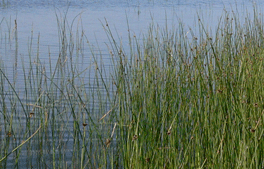 |
Monoculture of Schoenoplectus pungens in Wigwam Bay, Arenac County, Michigan |
habitats is Schoenoplectus (commonly known as the bulrushes). Schoenoplectus is a globally distributed genus of perennial monocots, predominantly occurring in emergent wetlands. Where Schoenoplectus occurs, it is often ecologically dominant. Schoenoplectus species are notoriously difficult to describe; species are defined based on few cryptic characters and hybridization is rampant. This project aims to use modern molecular methodology combined with advanced microscopy techniques to describe biodiversity, quantify variation, and clarify species descriptions in the North American members of the genus Schoenoplectus. A comprehensive systematic review of this group is essential to identify key species important for the protection, conservation, and maintenance of functioning wetland ecosystems.
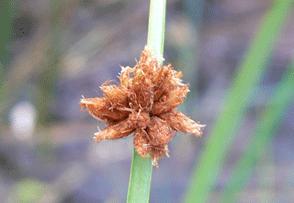 |
Schoenoplectus deltarum Thompson’s Bayou, Florida |
The Schoenoplectus pungens species complex includes interesting and dynamic wetland species of ecological and conservation importance (S. pungens, S. americanus and S. deltarum). Biodiversity in this group has been persistently difficult to describe using morphological characters and hybridization among species has been suggested. This project aims to describe species delimitations, biodiversity and hybridization in the S. pungens species complex by investigating variation in micro- and macroscopic morphological characteristics and estimating genetic relationships using three independent data sets: sequences from the nrITS region, sequences from trnT-L-F chloroplast spacer regions, and amplified fragment length polymorphisms from genomic DNA. Results of this investigation will help resolve evolutionary questions across the complex and relative to Schoenoplectus. Understanding biodiversity of this unique group of wetland plants is important in conserving diversity, communicating among scientists and describing the unique and diverse habitats in which they species are found.
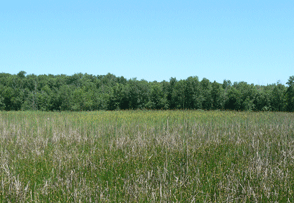 |
Schoenoplectus americanus Maple River, Michigan |
One of the few inland salt marshes remaining in the eastern portion of the United States can be found along the Maple River in Clinton County, Michigan. In this globally imperiled (G1) community, two plant species are locally abundant: Schoenoplectus americanus ( (Olney's bulrush) and S. pungens (Three-square bulrush). The S. americanus population is disjunct from Atlantic and Gulf coast populations and critically imperiled in the state (S1). Morphological analysis and herbarium specimens have indicated potential hybridization between S. americanus and S. pungens in this Michigan population. This is concerning for the overall fitness of the S. americanus population; hybridization can reduce fitness through loss of genetic integrity or out-breeding depression. This project aims to describe biodiversity, investigate hybridization and add insight into conservation strategies of S. americanus in the inland salt marshes of Michigan. By understanding the processes at work within S. americanus and S. pungens we can have a better understanding of biodiversity in these marsh habitats.
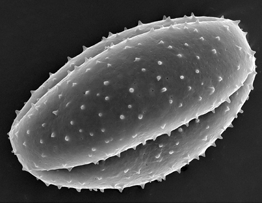 |
Cleome spinosa pollen grain |
|
Brassica nigra |
Pollen grain morphology and size are highly variable and the functional significance of this diversity is largely unknown. Several studies have hypothesized pollen size
is a product of the length of the style and the energy storage requirements of the pollen tube to reach the egg. Comparative methods are necessary to investigate the potential functional integration between style length and pollen grain size. This research project tests this theory in the mustard family (Brassicaceae). The Brassicaceae is an ideal group to investigate this pollen evolution question. It is a natural group, which has profound agronomic, economic and research import and a high level of variation in floral morphology and size. This project aims to examine and describe the diversity of pollen grain morphology in the mustard family using scanning electron and light microscopy. Pollen data will be combined with floral morphological data from the family. Pollen grain and floral trait measurements will be examined relative to an independent molecular phylogenetic hypothesis of historical relationships (based on two independent genes). The results of this project will provide insight into the potential evolution and significance of pollen grain variation.
Research on botanicals and herbal extracts is one of the most promising areas of discovery in medicine. Preliminary research on paramylon (ß-1, 3 glucan storage products found exclusively in euglenoid algae) indicates it is an important biological extract with potential for medicinal application. Research on paramylon grains from a single euglenoid species,
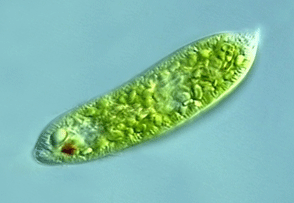 |
Euglena sanguinea |
|
Paramylon grain from Phacus pleuronectes |
Euglena gracilis, provides evidence that paramylon has anti-HIV, anti-microbial, and anti-tumor bioactivity. Different species in the diverse euglenoid lineage have different morphological forms of paramylon but their bioactivity has not been tested. This could indicate variable structure and forms of ß-1, 3 glucans which may have more potent or additional biological activities. The goal of this project is to examine morphological form and chemical structure of paramylon by sampling several diverse species across the euglenoid lineage looking for novel, potentially bioactive paramylon forms. In this study, SEM is being used to measure and compare crystalline structures among euglenoids. Accordingly, nuclear magnetic resonance has been initiated to elucidate chemical structure of the ß-1, 3 glucan molecules. Identifying morphological and molecular variation in paramylon grains is the first step in identifying new sources of ß-1, 3 glucans for medicinal application.
|
|
|
|
|
|